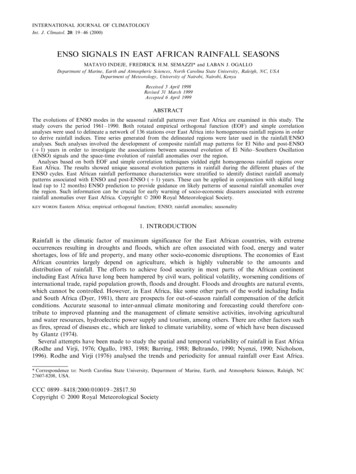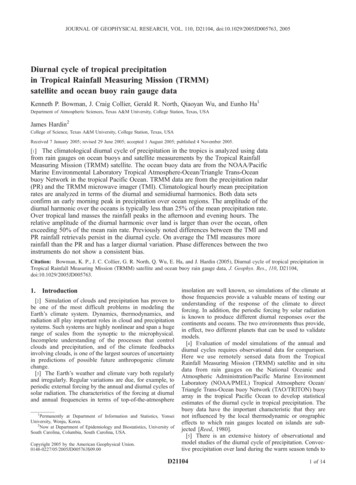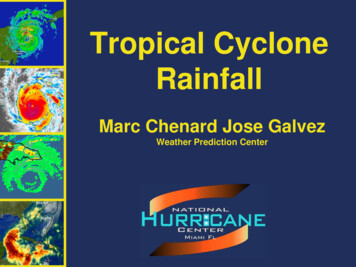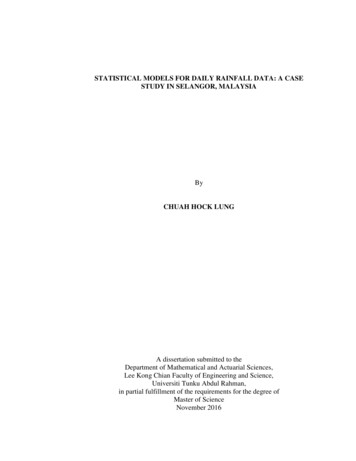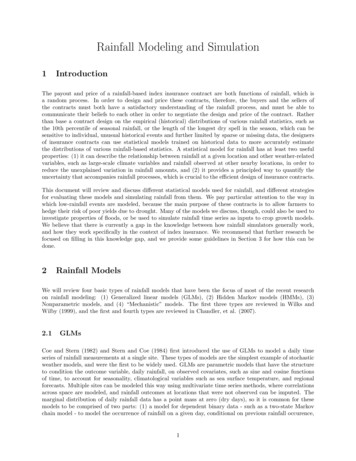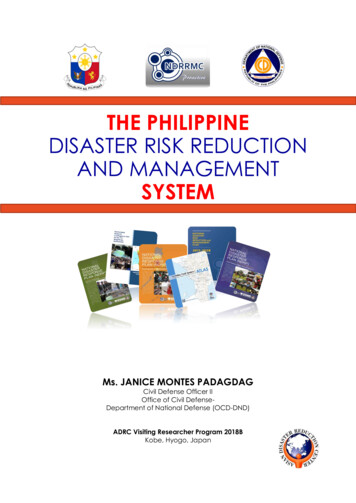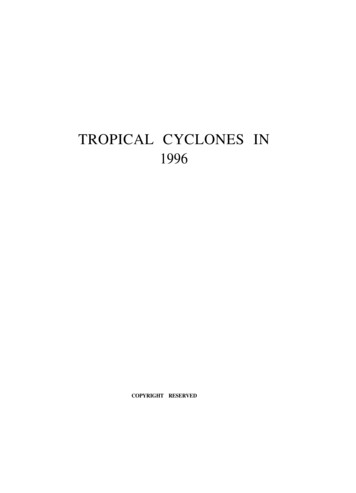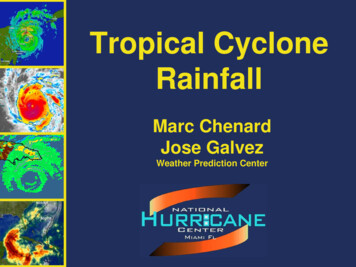
Transcription
Tropical CycloneRainfallMarc ChenardJose GalvezWeather Prediction Center
Outline Tropical Cyclone (TC) rainfall climatology Factors influencing TC rainfall TC rainfall forecasting tools TC rainfall forecasting process Weather Prediction Center (WPC) role inTC rainfall forecasting
Tropical Cyclone RainfallClimatology
Tropical Cyclone TracksCOMET (2011)
Global Mean Monthly TC Rainfall During the TCSeason and Percent of Total Annual RainfallData from TRMM 2A25 Precipitation Radar from 1998-2006Jiang andZipser (2010)
Contribution to Global Rainfall from TCs(1970-2014 rain gauge study) Globally, highest TC rainfall totals are in easternAsia, northwestern Australia, and thesoutheastern United States Percentage of annual rainfall contributed by TCs: 35-50%: NW Australia, SE China, northernPhilippines, Baja California 40-50%: Western coast of Australia, southIndian Ocean islands, East Asia, MexicoKhouakhi et al. (2017)J. Climate
Contribution to Global Rainfall from TCs(1970-2014 rain gauge study)Khouakhi et al. (2017)J. Climate
Annual TC RainfallEquatorTC Rain TC rainfall makes up alarger percentage of totalrainfall during years whenglobal rainfall is low Asymmetric - generallymore TC rainfall in theNorthern HemisphereTC Rain % ofTotal Rain TCs produce 10-17% ofglobal rain from 15-25 N TCs produce 5-10% ofglobal rain from 15-25 SFrank Marks (HRD)
Biggest TC Rain Producers ByCountry/IslandBelizeBermudaCanada829.8 mm32.67” Keith (2000)186.7 mm7.35”October 1939 Hurricane302.0 mm11.89” Harvey (1999)Cayman Islands764.8 mm31.29” Sanibel Island Hurricane (1944)Costa Rica920.0 mm36.22” Cesar (1996)Cuba2550.0 mm100.39”Flora (1963)Dominica825 mm32”Erica (2015)Dominican Rep.1001.5 mm39.43” Flora (1963)El Salvador1513 mm59.57” Twelve E (2011)Guadeloupe582.0 mm22.91” Luis (1995)Guatemala600.0 mm23.62” Mitch (1998)Haiti1447.8 mm57.00” Flora (1963)Honduras912.0 mm35.89” Mitch (1998)Jamaica3429.0 mm135.00”November 1909 HurricaneMartinique680.7 mm26.80” Dorothy (1970)Mexico1576.0 mm62.05” Wilma (2005)Nicaragua1597.0 mm62.87” Mitch (1998)Panama695.0 mm27.36” Mitch (1998)Puerto Rico1058.7 mm 41.68” T.D. #15 (1970)St. Lucia668.0 mm26.30” Tomas (2010)St. Martin/Maarten 866.6 mm34.12” Lenny (1999)Venezuela339.0 mm13.30” Brett (1993)Original Source: David Roth WPC (2006)
Characteristics of TC PrecipitationStratiform and Convective MechanismsStratiform Rain 50% of Total Rain from TCNOAA/HRD - Daily Radar Rainfall Estimate StudyTypical warm season 1-day totalPrimarilyConvectiveHurricane Irene (1999) 1-day totalStratiform&ConvectiveHurricane Irene (15 October 1999)Frank Marks (HRD)
TC Rainband ComplexesDidlake andHouze (2013) Convective CellsStratiformCell 1 (inner rainband)Weaker, shallower reflectivity coreWeaker updraftCell 2 (outer rainband)More intense reflectivity, heavier rainIncreased CAPE, more buoyant updraft Convection travels downwind andbecomes increasingly stratiform innature Primarily focuses in left-of-shearhalf of the storm
Factors Influencing TropicalCyclone Rainfall
What Factors Influence Rainfall fromTropical Cyclones? Movement – slow forward motion can produce more rain Storm size – the larger the storm, the greater the area typicallyreceiving rain Storm track – determines the location of the rain Diurnal cycle – heaviest rainfall generally near the storm centerovernight, outer band rainfall during the day Topography – enhances rainfall in upslope areas, but decreasesrainfall past the spine of the mountains Moisture – entrainment of dry air can redistribute and/or reducethe amount of precipitation; increased moisture can increaserainfall Interaction with other meteorological features (troughs, fronts,jets) and extratropical transition can greatly modify rainfalldistribution
Factors Influencing TC RainfallStorm Motion Slow vs. fast movingTCs TCs with a turning orlooping track vs.straight moverRainfall in Inches1 Inch 25.4 mmHurricane Mitch fatalities:Honduras: 5,677Nicaragua: 2,863Guatemala: 258El Salvador: 239
Factors Influencing TC RainfallWhen storms are unusually slow-moving ( 5 knots or less) and also unusuallypersistent in their tropical characteristics post-landfall, watch out for extremerainfall and potentially catastrophic flooding.
Factors Influencing TC RainfallStorm SizeDetermined by distance from center to outermost closed isobar 2 degrees“Very small”Marco(2008)2-3 degrees“Small”Ida(2009)3-6 degrees“Average”Frances(2008)6-8 degrees“Large”Wilma(2008) 8 degrees“Very large”Sandy(2012)Original Source: Joint Typhoon Warning Center
Factors Influencing TC RainfallStorm TrackHow far off are we withplacement of higher amounts?Consider a 2” rainfall object (idealized example).ForecastFcstHourAvg QPFErrorNHCTrackError2456 mi.42 mi.4865 mi.58 mi.7286 mi.90 mi.96126 mi.121 mi.120157 mi.178 mi.West Error ScenarioEast Error ScenarioRemember, thisis average errorStorm and forecast trackError statistics for both QPF andNHC from a specific subset of2016-2020 storms. May not matchlonger averages.
Factors Influencing TC RainfallTime of DayAlberto, July 4-5, 199404/18z05/06z00z12z18z
Factors Influencing TC RainfallTerrain ImpactsHeaviest rainfall favors mountains perpendicular to the windRainfall in Inches1 Inch 25.4 mmDavid Roth WPCHurricane Georges in Puerto Rico 1.75 billion in damage28,005 homes destroyed
Factors Influencing TC RainfallVertical Wind Shear – Northern HemisphereInnerOuterMore than 90% oflightning flashesoccurred downshearDownshear leftslightly favored withininner rainbandsDownshear rightfavored within outerrainbandsCorbosiero, Molinari
Factors Influencing TC RainfallVertical Wind Shear – Northern HemisphereShear directed acrossthe storm track leadsto more uniformdistribution of therainfallShear directedparallel to the stormtrack leads to adistribution of therainfall asymmetry onthe left side of thetrackRogers et al, 2003
Factors Influencing TC RainfallShear, Mesovortices, and Topography Downshear region of strongconvection associated withErika (2015) passed directlyover Dominica, producing over500 mm of rainfall Driven by 500-850 mbshear rather than deeplayer shear Mesovortex on the scale of 100 km developed withinErika’s circulation and persistedover Dominica for 3 hours,likely due to topographiceffects, enhancing heavyrainfallNugent and Rios-Berrios (2018, MWR)
Factors Influencing TC RainfallEnvironmental Steering in Northern Hemisphere Very slow moving TCs and symmetrical TCs produce the mostrainfall near the center Maximum rainfall at night(especially when over land)Weak steering flow TCs that move into a break in thesubtropical ridge often producemost of the rain right of their trackTRACKEven rainfalldistribution Rain oversmaller areaon right side Higher totals TCs that recurve due to significant upper troughs in thewesterlies often produce most of their rain left of their track Rainfall may spread well in advance of the TC due to interaction with theupper jet on the leading edge of the trough
Factors Influencing TC RainfallPredecessor Rainfall EventsPredecessor Rainfall Event (PRE)Image from Matt Cote and Lance Bosart –SUNY AlbanyRevised & Updatedfrom Fig. 13, Bosartand Carr (1978) Moisture transport well ahead of TC itselfCoherent area of rain displaced north of the TC (near a front or over terrain)Maximum rainfall rates can exceed 200 mm in 24 hrOccurs for approximately 1 of 3 landfalling TCs in U.S.
Factors Influencing TC RainfallOther Secondary Features and/or aSecondary features andCAGs (Central AmericanGyre) can result in heavyrainfall well away fromthe center of the TC.Especially whenorographic enhancementcomes into playCAGs are most commonearly and late in thehurricane season
Where is Flooding from TropicalCyclones More Likely to Occur? Areas where theground is alreadysaturated (low flashflood guidance values) Valleys/watersheds Areas of orographicenhancement Areas with poordrainage or prone torunoff Areas with directeddrainage that can beoverwhelmedCosta Ricastream floodingClear CutAreas in Haiti
TC Rainfall Forecasting Tools
Advantages of Microwave Products Geostationary IR data provides excellent spatiotemporalresolution, but is not optimal for rain estimation Microwave provides improved rainfall accuracy but at lowtemporal resolution Quantitative precipitation estimate (QPE) productsleverage each method’s strength Coldest cloud topsnot precipitating!
Satellite Rainfall https://gpm.nasa.gov/data/imergJAXCMORPH2, IMERG and JAX: Most sophisticated of theestimates. All use a combination of microwave andgeostationary satellite data to derive estimatedrainfall.QMORPH: advection of microwave rainfall estimatesHydro-Estimator: Only uses GOES IR imagerySCaMPER: IR imagery calibrated with Microwave ww.ospo.noaa.gov/Products/bRR/Product Animation.html
GOES-16/17 ProductsRainfall Rate Algorithm generates estimatesof instantaneous rainfall rate ateach IR pixel Uses IR brightnesstemperatures and calibrated inreal time against microwavederived rain rates to enhanceaccuracy The higher spatial andtemporal resolution availablefrom GOES-16 will be able toautomatically resolve rainfallrates on a finer scale
Ensemble Tropical RainfallPotential Product (eTRaP) 6-hourly Day 1 forecasts:Extrapolates polar orbitingsatellite rain rate along TCforecast tracks(AMSU, SSMI, AMSRE, TRMM) A satellite “member” is includedwhen its path passes over the TC “Members” are weightedaccording to age of pass and pastperformance of sensor Official forecast of TC track & atleast 2 members needed to createProbabilityQuantitativea ecast Updated daily at 0315, 0915,1515, and 2115 UTChttp://www.ssd.noaa.gov/PS/TROP/etrap.html
eTRaP: ity of 100 mmHurricaneIota24 hreTRaPforecastProbability of 150 mmProbability of 200 mmQPF
CLIQR: Picking an Analog for aTC Rainfall .htmlLooks at: The current rain shield size and compare it to TCsfrom the past How fast is the TC moving? Vertical wind shear in current/past events? Look for storms with similar or parallel tracks Is topography a consideration? Look for nearby fronts and examines the depth ofnearby upper troughs for current event and possibleanalogsNot all TC events will have a useful analog
Tropical Cyclone Rainfall ainfall.htmlCLIQR Matching TC List(Rainfall Matches Accessible viaHyperlink)Available for active TCs tmlDavid Roth WPC
GEFS Prob. ofExcedenceGlobal deterministic models, globalensemble means and probabilities,hurricane models, high resolution models GFS, NAM, GEFS ECMWF, ECMWF ensemble HWRF/HMON UKMET GEMGFS QPFHWRF QPFModel Forecasts
3km GFS QPF High resolution convectiveallowing models (CAMs) havemany advantages Resolve convective rain bandsbetter than global modelsGFS QPF Better depiction of orographicenhancement and rainshadowing Better signal of potential upperbound of rainfall magnitudes Coverage and availability ofCAMs should continue toincrease over the coming yearsModel Forecasts
Where to Find Model QPFs NCEP models (GFS, NAM, GEFS, NAEFS) includingtropical guidance (HWRF and HMON)http://mag.ncep.noaa.gov NAVGEMhttp://www.nrlmry.navy.mil/metoc/nogaps/ ECMWFhttps://www.ecmwf.int/en/forecasts/charts Penn State Tropical Atlantic E-Wallhttp://mp1.met.psu.edu/ fxg1/ewalltropatl.html Tropical dels/ HWRF/HMON/ experimental guidancehttps://www.emc.ncep.noaa.gov/gc viewer/
TC QPF Forecast Process
NWS Tropical Cyclone QuantitativePrecipitation Forecasts (QPF)WFO QPFWPC QPF
Production of Tropical CycloneQuantitative Precipitation ForecastsA good place to start is the model closest to the NHC track forecastDay 1 QPF24-h ending 12Z 21 Aug 2008 –T.S. FayNHC TrackForecast Issuedat 09Z 20 AugModel trends areimportant. Look atlast several runs of aparticular model tosee if a persistenttrend is seen.Run to runconsistency andmodel to modelconsistency canincrease confidence“a primary determinant of tropical cyclone QPF errorsis track forecast error”– Marchok et al 2007
Production of Tropical CycloneQuantitative Precipitation ForecastsUse observations and recent model data to determine thecurrent structure/rainfall rates Do the models have a good handleon the current storm structure? If yes, then more trust in modelQPF forecasts going forwardModel dataSatellite QPEsRadar If not, adjustments to the modelsmay be needed. Is the structureexpected to change? Models tend to struggle most withstructure during thedevelopmental phase of a systemand with weaker/disorganizedsystems
Production of Tropical CycloneQuantitative Precipitation ForecastsLocate relevant synoptic scale and meso-scale boundariesHurricaneRina (2011)
Production of Tropical CycloneQuantitative Precipitation ForecastsUse conceptual models and pattern recognition to further adjustQPF as needed Model QPF forecasts have improvedconsiderably over the last coupledecades Often have a good handle onapproximate magnitudes andplacement of higher QPF (left or rightof track) However, conceptual models andpattern recognition can becomeimportant when models are notproperly depicting the initialstructure/size/intensity of the storm
Production of Tropical CycloneQuantitative Precipitation ForecastsIdentify areas of orographic enhancementSlopes Favored ForHeavy PrecipitationLOW LEVELWIND
Production of Tropical CycloneRelated QPFDetermine how a change in available moisture could increase,decrease, or redistribute rainfall
Production of Tropical CycloneRelated QPFUse climatology (CLIQR, R-CLIPER, TC Rainfall Climatology)and data from past storms to: Increase/decrease amountsAdjust numerical guidance biasesReality checkHighlight areas significantly impacted by terrain effects
Summary Remember factors that influence TC rainfall– Size of storm, time of day, speed etc. Evaluate quality of the model data compared to currentconditions Assess the amount of shear in the environment– How will it influence rainfall? Are there past TCs that resemble the rainfall distributionand forecast of the TC? Use all of the tools available– Satellite rainfall products, NWP models, etc. Remember, heavy rain can also occur well away fromthe TC itself– PREs, secondary disturbances, CAG, etc.
Role of the Weather Prediction Center (WPC)WPC responsible for thewording of the rainfall statementincluded within NHC publicadvisories (TCP) beginning in2005 WPC produces QPF and excessive rainfallgraphics for systems impacting the CONUS For all other NHC systems WPC isresponsible for the rainfall statement andKey Message related to rainfall hazards The WPC Senior Branch Forecaster (SBF) isresponsible for issuing these products incoordination with the WPC InternationalDesk (ID). More info on that desk next. WPC SBF also coordinates these productswith NHC and the NWC (for systemsimpacting Puerto Rico/Hawaii or CONUS)
Role of the WPC International Desks (ID)Provide support to Caribbean andCentral American nations byproducing products similar to those forthe US1) QPF Charts: Coordinated with NHC and WPC SBF.QPF Charts follow WPC/NHC formats. Non-official forecasts, but they arelargely valued by RA-IV NWS as tools toproduce their official QPF; and by USAIDand US SOUTHCOM for planningpurposes.2) Input to NHC’s rainfall statements fornon-US locationsQPE3) Help generating or coordinating thegeneration of QPE charts.
Steps to generate an ID QPF ChartIdentification of a perturbationthat poses a heavy rainfall threatto the Caribbean or CentralAmerica in several guidanceoptions and/ or satelliteQPF Chart Generation or Update(by 11:30 UTC daily, w hile the threat exists) NHC’s track and intensity used as the base Consistency w ith previous forecasts and NHC’srainfall statementYESIs NHC tracking it?NO If less than 2 days aw ay: Consider satellite signatures(e.g. health of outflow , dry air entrainment convectionin core, precipitable w ater, ETRAP estimates, rainfallobservations)Raise aw areness: Briefemail to partnersChart Disseminationvia email to partners*Partners: USAID, US SOUTHCOM,NHC TAFB, NOAA International Affairsand NW S in the potential path. Consider: Rainfall from many models. W eightcloseness to NHC’s track, recent model skill, SST andanomalies along track, cyclone speed, synopticfeatures in track, potential topographic enhancement.YESDoes everyone agree?Coordinate w ith W PC SBF and NHCTAFB. Include San Juan W FO ifrelevant.NOChart adjusted accordingly
Thank YouQuestions?
rain/web/cliqr.html. CLIQR Matching TC List (Rainfall Matches Accessible via Hyperlink) David Roth WPC. Model Forecasts: GEFS Prob. of Excedence: GFS QPF. HWRF QPF. Global deterministic models, global ensemble means and probabilities, hurricane models, high resolution models .
